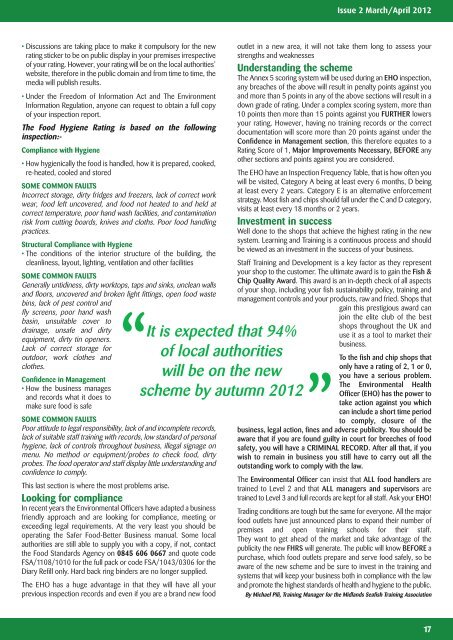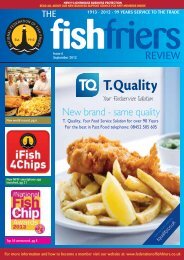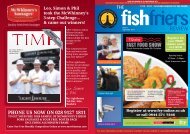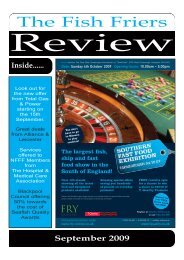Fish friers Review - Mar / Apr 2012 - Issue 2 - National Federation of ...
Fish friers Review - Mar / Apr 2012 - Issue 2 - National Federation of ...
Fish friers Review - Mar / Apr 2012 - Issue 2 - National Federation of ...
Create successful ePaper yourself
Turn your PDF publications into a flip-book with our unique Google optimized e-Paper software.
Discussions are taking place to make it compulsory for the new<br />
rating sticker to be on public display in your premises irrespective<br />
<strong>of</strong> your rating. However, your rating will be on the local authorities’<br />
website, therefore in the public domain and from time to time, the<br />
media will publish results.<br />
Under the Freedom <strong>of</strong> Information Act and The Environment<br />
Information Regulation, anyone can request to obtain a full copy<br />
<strong>of</strong> your inspection report.<br />
The Food Hygiene Rating is based on the following<br />
inspection:-<br />
Compliance with Hygiene<br />
How hygienically the food is handled, how it is prepared, cooked,<br />
re-heated, cooled and stored<br />
SOME COMMON FAULTS<br />
Incorrect storage, dirty fridges and freezers, lack <strong>of</strong> correct work<br />
wear, food left uncovered, and food not heated to and held at<br />
correct temperature, poor hand wash facilities, and contamination<br />
risk from cutting boards, knives and cloths. Poor food handling<br />
practices.<br />
Structural Compliance with Hygiene<br />
The conditions <strong>of</strong> the interior structure <strong>of</strong> the building, the<br />
cleanliness, layout, lighting, ventilation and other facilities<br />
SOME COMMON FAULTS<br />
Generally untidiness, dirty worktops, taps and sinks, unclean walls<br />
and floors, uncovered and broken light fittings, open food waste<br />
bins, lack <strong>of</strong> pest control and<br />
fly screens, poor hand wash<br />
basin, unsuitable cover to<br />
drainage, unsafe and dirty<br />
equipment, dirty tin openers.<br />
Lack <strong>of</strong> correct storage for<br />
outdoor, work clothes and<br />
clothes.<br />
Confidence in Management<br />
How the business manages<br />
and records what it does to<br />
make sure food is safe<br />
“<br />
It is expected that 94%<br />
<strong>of</strong> local authorities<br />
will be on the new<br />
scheme by autumn <strong>2012</strong><br />
SOME COMMON FAULTS<br />
Poor attitude to legal responsibility, lack <strong>of</strong> and incomplete records,<br />
lack <strong>of</strong> suitable staff training with records, low standard <strong>of</strong> personal<br />
hygiene, lack <strong>of</strong> controls throughout business, illegal signage on<br />
menu. No method or equipment/probes to check food, dirty<br />
probes. The food operator and staff display little understanding and<br />
confidence to comply.<br />
This last section is where the most problems arise.<br />
Looking for compliance<br />
In recent years the Environmental Officers have adapted a business<br />
friendly approach and are looking for compliance, meeting or<br />
exceeding legal requirements. At the very least you should be<br />
operating the Safer Food-Better Business manual. Some local<br />
authorities are still able to supply you with a copy, if not, contact<br />
the Food Standards Agency on 0845 606 0667 and quote code<br />
FSA/1108/1010 for the full pack or code FSA/1043/0306 for the<br />
Diary Refill only. Hard back ring binders are no longer supplied.<br />
The EHO has a huge advantage in that they will have all your<br />
previous inspection records and even if you are a brand new food<br />
<strong>Issue</strong> 2 <strong>Mar</strong>ch/<strong>Apr</strong>il <strong>2012</strong><br />
outlet in a new area, it will not take them long to assess your<br />
strengths and weaknesses<br />
Understanding the scheme<br />
The Annex 5 scoring system will be used during an EHO inspection,<br />
any breaches <strong>of</strong> the above will result in penalty points against you<br />
and more than 5 points in any <strong>of</strong> the above sections will result in a<br />
down grade <strong>of</strong> rating. Under a complex scoring system, more than<br />
10 points then more than 15 points against you FURTHER lowers<br />
your rating. However, having no training records or the correct<br />
documentation will score more than 20 points against under the<br />
Confidence in Management section, this therefore equates to a<br />
Rating Score <strong>of</strong> 1, Major Improvements Necessary, BEFORE any<br />
other sections and points against you are considered.<br />
The EHO have an Inspection Frequency Table, that is how <strong>of</strong>ten you<br />
will be visited, Category A being at least every 6 months, D being<br />
at least every 2 years. Category E is an alternative enforcement<br />
strategy. Most fish and chips should fall under the C and D category,<br />
visits at least every 18 months or 2 years.<br />
Investment in success<br />
Well done to the shops that achieve the highest rating in the new<br />
system. Learning and Training is a continuous process and should<br />
be viewed as an investment in the success <strong>of</strong> your business.<br />
Staff Training and Development is a key factor as they represent<br />
your shop to the customer. The ultimate award is to gain the <strong>Fish</strong> &<br />
Chip Quality Award. This award is an in-depth check <strong>of</strong> all aspects<br />
<strong>of</strong> your shop, including your fish sustainability policy, training and<br />
management controls and your products, raw and fried. Shops that<br />
gain this prestigious award can<br />
join the elite club <strong>of</strong> the best<br />
“<br />
shops throughout the UK and<br />
use it as a tool to market their<br />
business.<br />
To the fish and chip shops that<br />
only have a rating <strong>of</strong> 2, 1 or 0,<br />
you have a serious problem.<br />
The Environmental Health<br />
Officer (EHO) has the power to<br />
take action against you which<br />
can include a short time period<br />
to comply, closure <strong>of</strong> the<br />
business, legal action, fines and adverse publicity. You should be<br />
aware that if you are found guilty in court for breeches <strong>of</strong> food<br />
safety, you will have a CRIMINAL RECORD. After all that, if you<br />
wish to remain in business you still have to carry out all the<br />
outstanding work to comply with the law.<br />
The Environmental Officer can insist that ALL food handlers are<br />
trained to Level 2 and that ALL managers and supervisors are<br />
trained to Level 3 and full records are kept for all staff. Ask your EHO!<br />
Trading conditions are tough but the same for everyone. All the major<br />
food outlets have just announced plans to expand their number <strong>of</strong><br />
premises and open training schools for their staff.<br />
They want to get ahead <strong>of</strong> the market and take advantage <strong>of</strong> the<br />
publicity the new FHRS will generate. The public will know BEFORE a<br />
purchase, which food outlets prepare and serve food safely, so be<br />
aware <strong>of</strong> the new scheme and be sure to invest in the training and<br />
systems that will keep your business both in compliance with the law<br />
and promote the highest standards <strong>of</strong> health and hygiene to the public.<br />
By Michael Pili, Training Manager for the Midlands Seafish Training Association<br />
17











